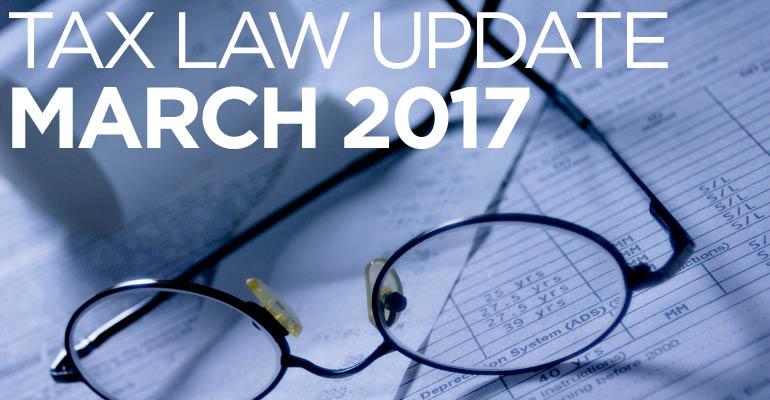• Private letter ruling allows reformation of trusts so that they qualify as grantor retained annuity trusts (GRATs)—In PLR 201652002 (released Dec. 23, 2016), the Internal Revenue Service allowed a trustee to reform several trusts so that they qualified as GRATs. The reformation added language to each trust instrument to qualify the grantor’s interest in each trust as a qualified interest under Treasury Regulations Sections 25.2702-2 and 25-2702-3. The modifications were effective retroactively, as of the date each trust was created.
The grantor’s attorney drafted several irrevocable trusts, all of which were intended to qualify as GRATs under Internal Revenue Code Section 2702(b)(1). The grantor’s attorney failed to include language prohibiting the trustees from issuing a note, other debt instrument, option or other similar financial arrangement in satisfaction of the annuity obligation, as required by Treas. Regs. Section 25.2702-3(d)(6).
However, each trust contained language giving the trustees “the power to amend the Trust Indenture in any manner that may be required for the purpose of ensuring that the Grantor’s retained interest in the Trust qualifies and continues to qualify as a ‘qualified interest’ within the meaning of Section 2702(b)(1) of the Code.” Furthermore, a state statute provided that, “to achieve the settlor’s tax objectives . . . in a manner that is not contrary to the settlor’s probable intent,” an “interested person” may modify the terms of a trust, and such modification may have retroactive effect. Pursuant to the statute, the trustees filed an action with the court to reform the trusts to add the language required by Treas. Regs. Section 25.2702-3(d)(6) as of the date of each trust’s creation.
The IRS held that the judicial reformation was effective and recognized it as retroactive. Therefore, the grantor’s interest in each trust was a qualified interest under IRC Section 2702 as of the date each trust was created.
• IRS Notice 2017-12 explains how to confirm closing of an examination of an estate tax return—On Jan. 6, 2017, the IRS issued Notice 2017-12. The notice provides guidance on the methods available to confirm the closing of an examination of a decedent’s estate tax return. Specifically, the notice announces that an account transcript issued by the IRS can serve as the “functional equivalent” of an estate tax closing letter (Letter 627), in that each of these documents may serve to provide estates and their representatives notice that the IRS has closed a decedent’s estate tax return. Importantly, the IRS stated it will no longer automatically issue estate tax closing letters for every estate tax return that was filed after June 30, 2015 (with the exception of those returns that were filed solely for the purpose of electing portability, and the portability election was denied). Therefore, going forward, the account transcript will likely be the primary means by which estates and their representatives are provided notice that the IRS has closed an estate tax return.
An account transcript is a computer-generated report, available free of charge, that provides current account data such as payment history, refund history, penalties assessed and the date on which the examination was closed. An account transcript presents this data by including numerical codes and descriptions of what each of these codes indicates. For example, code “421” indicates “closed examination of estate tax return.” Therefore, an account transcript showing a transaction code of “421” can independently serve the same purpose as an estate tax closing letter.
Typically, after the issuance of a closing letter or the entry of transaction code “421” on an account transcript, the IRS examination of the corresponding estate tax return is closed. However, the IRS may reopen the examination of an estate tax return after the issuance of a closing letter or the entry of transaction code “421” on an account transcript for the purpose of determining the estate tax liability of a decedent under circumstances described in the closing letter, Revenue Procedure 2005-32 and Rev. Proc. 2005-1.
Rev. Proc. 2005-32, Rev Proc. 2005-1 and the estate tax closing letter provide that an estate tax closing letter doesn’t prevent the IRS from reopening or re-examining the estate tax return to determine estate tax liability if there’s: (1) evidence of fraud, malfeasance, collusion, concealment or misrepresentation of a material fact, (2) a clearly defined, substantial error based on an established IRS position, or (3) another circumstance indicating that a failure to reopen the case would be a serious administrative omission. Additionally, in the case of the estate of a decedent (survived by a spouse) who elects portability of the deceased spousal unused exclusion (DSUE) amount, the issuance of an estate tax closing letter doesn’t prevent the IRS from examining the estate tax return of that decedent for the purpose of determining the transfer tax liability of the surviving spouse of that decedent (specifically, the DSUE amount to be included in the applicable exclusion amount of the surviving spouse).
Estates and their authorized representatives may request an account transcript by filing Form 4506-T, Request for Transcript of Tax Return via mail or facsimile (per the instructions on the form). Account transcripts for estate tax returns aren’t currently available through the IRS’ automated online system, but the IRS website will have current information should an automated online method become operational. Those who wish to receive an estate tax closing letter may call the IRS at 866-699-4083 to request one. Requests for either document should be made no earlier than four months after filing the estate tax return.





